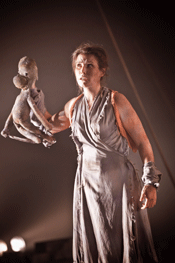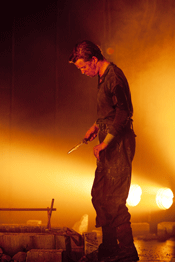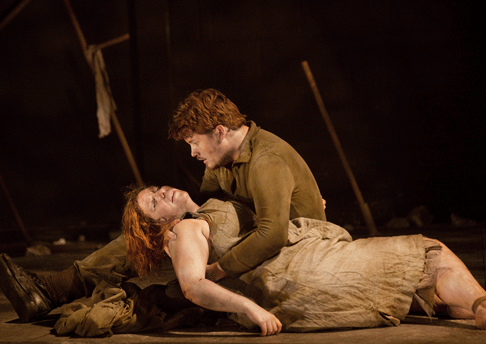Written in 1799, just before the three best known operas, L’isola disabitata is enjoying a major revival all of its own, thanks to the 2007 edition used at the Young Artists production in the Linbury Studio at the Royal Opera House, London. It’s short, snappy and there are no high male voices.
 Anna Devin as Silvia
Anna Devin as Silvia
Its beauty lies in its Spartan simplicity. This is a deserted island, after all. As with so much pre 19th century music, elaboration masks strong basic themes. L’isola disabitata is remarkably clear sighted. It’s about keeping faith, despite adversity.
Constanza (Elisabeth Meister) is a woman who has been on an isolated island for 13 years. She thinks she’s been deserted by her husband Genandro (Steven Ebel). The name “Constanza” means “constancy”, but Constanza is no passive saint like Penelope in Greek myth who kept faith with Odysseus when he wandered. Constanza gets angry, so mad that she almost becomes mad with bitterness. She passes the years by incising an inscription deeper and deeper into the surface of a rock. It’s a powerfully potent curse. Her love has turned to unrelenting hate.
When Constanza was abandoned, she held her infant sister in her arms. Silvia (Anna Devlin) is a feral child, who has grown up in isolation, knowing nothing of “civilized” society. She’s had no role model other than Constanza, so she’s been taught to fear men. While Constanza turns inward, Silvia enjoys the island, living with nature (symbolized in this production by a toy animal which also indicates her innocence).
Mysteriously, Gernando (Steven Ebel), her husband returns to the island. He hadn’t deserted Constanza of his own free will, but had been kidnapped by marauding soldiers. Recognizing the surroundings, he sets out to search for her and save her. Eventually they are reunited. Constanza destroys the curse, realizing it was wrong. Faith triumphs, against all odds.
 Daniel Grice as Enrico
Daniel Grice as Enrico
Silvia who has been taught to hate men, encounters Gernando’s companion, Enrico (Daniel Grice). At first she fears him, but they fall in love. Silvia and Enrico form a standard love interest sub plot, which enlivens the otherwise grim tale of Constanza’s suffering. But Haydn’s also commenting on the idea of society in Arcadian surroundings. He’s very much in tune with the philosophy of Jean-Jacques Rousseau. Although L’isola disabitata predicates on marital fidelity, there are deeper, less explicit political implications.
Perhaps it’s no surprise then that this opera should appeal to modern audiences. Although Haydn worked for Prince Esterh·zy, he wasn’t subservient, as his Symphony no 45, “The Farewell” indicates. The American Revolution showed how potent Rousseau’s political concepts could be, the French Revolution signaled the end of Absolute Monarchy. Musically, too, Haydn understood the Zeitgeist. Classical poise tempered baroque opulence. The Sturm und Drang movement, which so influenced Haydn was a precursor of what we now called Romanticism, which ushered in further revolutions in the arts and society.
Although L’isola disabitata is set on an island, the island is in fact no more than a structural concept indicating a situation cut off from the reality of normal society. Haydn uses a contemporary text, by Pietro Metastasio, which refers to barren rocks and smoke — metaphors of oppression, and of Constanza’s moral confusion. Hence the layer of smoke that filled the Linbury Studio Theatre for this production by the Royal Opera House Young Artists programme, enveloping set and singers in the mist. Suddenly there’s a sound of running water. Until the conductor (Volker Krafft) climbs out of the pit, you’re not sure whether the first part of the opera is over or not. Just as Constanza’s disoriented, so are we.
A friend observed that the set “looks like a bomb site”. She’s right, for Constanza must have felt that she’d been hit by disaster. The designs (Jamie Vartan) reflect Constanza’s emotional landscape. She’s desolate, ruined, shattered. She’s lost faith because she invested in the trappings of marriage, rather than love.
 Elisabeth Meister as Constanza and Gernando Steven Ebel as Gernando
Elisabeth Meister as Constanza and Gernando Steven Ebel as Gernando
The spartan designs in this production also reflect Haydn’s music. L’isola disabitata uses only four voices, each distinctly defined and characterized. Until they’re united at the end, they sing alone, reflecting the characters’ inability to link up. The orchestra’s small — nineteen strings, with only two horns, two oboes, bassoon and flute. Minimalist by 19th century standards.
Musically, it’s also “modern”, in the sense that the voice parts are direct and communicate without excess adornment. The orchestral writing follows the words intimately. Sometimes one instrument shadows a voice, delicately picking up details. It’s word painting, almost as sensitive as Lieder would become.
Elisabeth Meister and Steven Ebel excel. Both have been prominent in the Jette Parker Young Artists scheme for some time, and have been heard many times in smaller roles in the main House. Meister memorably stepped in at short notice to sing the Fox in The Cunning Little Vixen. She sang with Ebel in Ebel’s The Truth about Love at the Linbury last year. He also sang Rimenes in Arne’s Atarxerxes. All these have been reviewed in Opera Today — please follow the links.
Daniel Grice’s Enrico was also good — I’d like to hear more of him. Anna Devin’s singing was rather obscured because she had to jump about so much. It’s in keeping with the idea of Silvia as a wild child unfettered by society, so director Rodula Gaitanou and movement director Mandy Demetriou are making a valid point, though overdone.
But the point of Young Artists presentations is learning through experience. There’s more to performance than technical prowess. Life skills count too. Please read “Polishing gemstones” where Simona Mihai and Kai R¸¸tel speak on the benefits of the Programme, one of the most highly regarded in Europe. The scheme also trains people in all aspects of opera, such as the conductor Volker Krafft, the director, designer, lighting and fighting. It’s tough being a creative artist especially in this financial climate. But if this excellent performance of Haydn L’isola disabitata is anything to go by, the Young Artists have proved themselves.
Anne Ozorio
image=http://www.operatoday.com/ISOLA—00086-MEISTER-AS-CO.gif
image_description=Elisabeth Meister as Constanza [Photo by Johan Persson courtesy of The Royal Opera]
product=yes
product_title=Franz Joseph Hadyn: L’isola disabitata
product_by=Constanza: Elisabeth Meister; Gernando: Steven Ebel; Silvia: Anna Devin; Enrico: Daniel Grice. Conductor: Volker Krafft. Director: Rodula Gaitanou. Designer: Jamie Vartan. Movement Director: Mandy Demetrious. Fight Director: Philip d’Orleans. Southbank Sinfonia. Linbury Studio Theatre, Royal Opera House, London, 28th October 2010.
product_id=Above: Elisabeth Meister as Constanza
All photos by Johan Persson courtesy of The Royal Opera